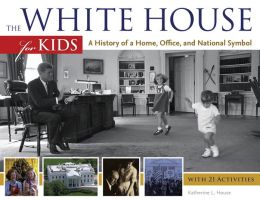There didn’t used to be a Presidents Day; instead, Americans observed Lincoln (Feb. 12) and Washington (Feb. 22) separately. But since those two had thoughtfully arranged to be born in the same month, and achieve the rank of Best President, and we didn’t want to slight the other 42 (I guess)—why not just slide them together, slap an inclusive label on it, and give all government workers a day off? That’s the American way! Betsy and Megan already compiled a list of books you’re likely to have in your local library, but here are a few new titles to bookmark for next year:
Rutherford B., Who Was He?: Poems about Our Presidents, by Marilyn Singer, illustrated by John Hendrix. Hyperion, 2013, 56 pages. Age/interest level: 7-10.
Somebody thought this was such a good idea it was worth another go (see our librarians’ take on The President’s Stuck in the Bathtub, from 2012). The layout is often ingenious; after a stentorian  take on George Washington, Adams and Jefferson are poeticized in dialogue, presenting two opposing views of how the republic should be run. This of course was historically the case—from good friends to bitter enemies to burying the hatchet in old age. And how about that John Tyler: Although those Whigs became his exes,/ Still he managed to annex Texas. And remember Harding? With his health it was a risk, though:/ His heart gave out in San Francisco. For some of the presidents, the author compacts a lot in very few lines. Her poem about James K. Polk is as direct and economical as the man himself: . . . A powerful president, with plenty of gall;/ Made four promises, kept them all. But other presidential figures get short shrift: the Jackson/van Buren administrations are reduced to Indian removal, and all we know about Taft is . . . yep, that infamous bathtub. Conservatives may bristle at her comparison of Carter (a humble, visionary farmer with good intentions) with Reagan (a cypher, seen from the eyebrows up, of whom no objective opinion can be formed). And JFK gets the eternal-flame treatment: Yet he gave us hope. He gave us the moon./ He gave us a presidency that ended too soon.
take on George Washington, Adams and Jefferson are poeticized in dialogue, presenting two opposing views of how the republic should be run. This of course was historically the case—from good friends to bitter enemies to burying the hatchet in old age. And how about that John Tyler: Although those Whigs became his exes,/ Still he managed to annex Texas. And remember Harding? With his health it was a risk, though:/ His heart gave out in San Francisco. For some of the presidents, the author compacts a lot in very few lines. Her poem about James K. Polk is as direct and economical as the man himself: . . . A powerful president, with plenty of gall;/ Made four promises, kept them all. But other presidential figures get short shrift: the Jackson/van Buren administrations are reduced to Indian removal, and all we know about Taft is . . . yep, that infamous bathtub. Conservatives may bristle at her comparison of Carter (a humble, visionary farmer with good intentions) with Reagan (a cypher, seen from the eyebrows up, of whom no objective opinion can be formed). And JFK gets the eternal-flame treatment: Yet he gave us hope. He gave us the moon./ He gave us a presidency that ended too soon.
The illustrations are clever without being too cartoonish, and many of them incorporate the presidents’ own words. A big problem with historical poetry books is that in striving for rhyme one leaves a lot behind, chiefly context. The book is officially recommended for ages 6-8, but kids on the younger side of that range won’t know enough to appreciate the poems. Older kids won’t either, but short biographies in the back of the book help round out the picture.
- Worldview/moral value: 3 (out of 5; basically neutral)
- Literary/artistic value: 4
The White House for Kids: a History of a Home, an Office, and a National Symbol with 21  Activities. Chicago Review Press, 2014, 144 pages. Age/interest level: 9-up.
Activities. Chicago Review Press, 2014, 144 pages. Age/interest level: 9-up.
The title pretty much says it all. This is another entry in the “For Kids” series published by CRP, which seems to be adding titles every month. We reviewed a couple of their science biographies last fall, and the formula marches on: timeline, history, photos and diagrams, anecdotes and sidebars and the 21 activities, which in this case range from baking chocolate cookies like Chelsea Clinton to making stilts like those rambunctious Roosevelt boys. Some of the activities don’t seem to have much to do with the White House, but in others you can learn to play “Hail to the Chief,” or sign your name like the President does. The text, as promised in the title, focuses on the house itself, not so much the presidents and historical events: its history (did you know it was closed for renovation for three years during the Truman administration?), presidential kids, the presidential office, the numerous staff that remains while first families come and go, entertaining and holidays, etc. It’s generally fun and informative, with activities for every taste (literally, with the cookies and punch!) and inclination.
- Worldview/moral value: N/A
- Literary value: 3.5
Thomas Jefferson Builds a Library, by Barb Rosenstock, illustrated by John O’Brien. Calkins Creek, 2013, 32 pages. Age/interest level: 6-8.
A life of TJ with a very definite theme. You’ll know from page 1 that he loved books and read all the  time: Thomas Jefferson learned to read. And then, he never stopped. He sat and he read. He walked and he read. And lying in bed, instead of sleeping, he read. Not just in English, either: by the time he went to France to serve as ambassador, he could read books in French, Latin, Italian, Greek, and Spanish. To gather from this account, he obsessed over books—not just reading, but binding, organizing and reorganizing, buying and selling (mostly buying). This may be a bit much for the average kid, whose relationship to books is only mildly friendly, but it’s an interesting framework for the man’s life and accomplishments, which are considerable. Illustrations are done in a lively, semi-pointillist style with books freely incorporated in the page design. The narrative ends, fittingly, with Jefferson offering 6500+ books from his own collection to Congress after the British burned the original congressional library in 1814. Those books became the backbone of the Library of Congress, which today is the largest in the world.
time: Thomas Jefferson learned to read. And then, he never stopped. He sat and he read. He walked and he read. And lying in bed, instead of sleeping, he read. Not just in English, either: by the time he went to France to serve as ambassador, he could read books in French, Latin, Italian, Greek, and Spanish. To gather from this account, he obsessed over books—not just reading, but binding, organizing and reorganizing, buying and selling (mostly buying). This may be a bit much for the average kid, whose relationship to books is only mildly friendly, but it’s an interesting framework for the man’s life and accomplishments, which are considerable. Illustrations are done in a lively, semi-pointillist style with books freely incorporated in the page design. The narrative ends, fittingly, with Jefferson offering 6500+ books from his own collection to Congress after the British burned the original congressional library in 1814. Those books became the backbone of the Library of Congress, which today is the largest in the world.
- Worldview/moral value: 3
- Literary/artistic value: 4
To Dare Mighty Things: the Life of Theodore Roosevelt, by Doreen Rappaport, illustrated by C. F. Payne. Hyperion, 2013, 48 pages. Age/interest level: 6-10.
The librarians commented on this book last week, but I can’t resist. Within these covers, from which his broad face beams, we learn that it was TR’s first wife who bestowed his nickname, that as New York city police commissioner he raised a ruckus by closing bars on Sunday, and that Republicans were as nasty then as they are now. Even though TR was himself (Shh! Don’t tell!) a Republican. The author admits that, but doesn’t have much use for the rest of the party. For instance: Many Republican lawmakers in the Capital sighed with relief when Teddy left [his federal position] to become New York City’s Police Commissioner. And later, Republican lawmakers in New York sighed with relief when Teddy left for Washington in 1897 to become Assistant Secretary of the Navy. And after he became president, Many Republicans disapproved of Teddy’s actions [to reform child labor laws and establish meat-packing standards]. And when his term was over, Returning home, he was so unhappy with what Republicans were saying, that he formed a new political party: the progressive Bull Moose Party. But he lost, and Republicans doubtless sighed with relief. In all the land, there doesn’t seem to have been anything called a “Democrat.” But okay. Though admiring of her subject, the author is honest about his extra-constitutional actions and outright war-mongering prior to the Spanish-American War. And the illustrations are outstanding. Famous TR quotes are woven through the text, and a chronology rounds it out.
- Worldview/moral value: 3
- Literary/artistic value: 4
For more presidential biography, see the links on last week’s Librarians list. Another fun presidential book you might try is Ghosts of the White House, by Cheryl Harness, in which a little girl wanders away from her White House tour group and encounters the shades of former residents—all illustrated in her fluid, packed style. We’ve admired Cheryl’s history books here, and interviewed her here.
Support our writers and help keep Redeemed Reader ad-free by joining the Redeemed Reader Fellowship.
Stay Up to Date!
Get the information you need to make wise choices about books for your children and teens.
Our weekly newsletter includes our latest reviews, related links from around the web, a featured book list, book trivia, and more. We never sell your information. You may unsubscribe at any time.
We'd love to hear from you!
Our comments are now limited to our members (both Silver and Golden Key). Members, you just need to log in with your normal log-in credentials!
Not a member yet? You can join the Silver Key ($2.99/month) for a free 2-week trial. Cancel at any time. Find out more about membership here.
1 Comments
Leave a Comment
You must be logged in to post a comment.


I can’t wait to check out the Marilyn Singer poetry book! She’s written some great collections before, and this one looks fun.